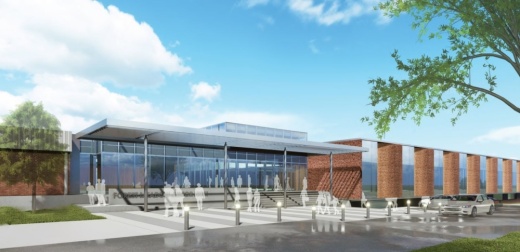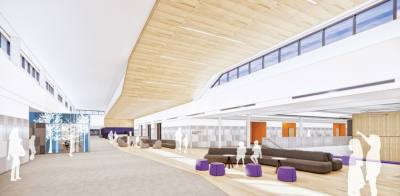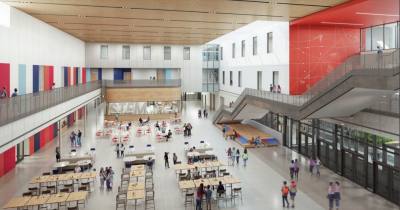The purpose of the project is to move the district’s sixth graders from the elementary schools they attend into the new middle schools. The junior high campuses are used for grades seven and eight.
The district is expected to spend over $150 million to rearrange and create new campuses. The first two campuses set to open as middle schools are Forest Meadow and Lake Highlands junior highs. Construction started on both campuses this summer and is expected to continue until at least 2024.
RISD Superintendent Tabitha Branum said the junior high model is outdated for a modern school district and that 95% of districts in Texas are using the middle school model. This new system will solve campus capacity issues for the district while providing more academic and social assistance opportunities for students, Branum said.
“I just think this provides an excellent opportunity for us to now have the sixth through eighth graders all under one roof,” said Susan Burt, Forest Meadow Junior High principal.
Funds from the 2021 RISD bond will be used to pay for the Lake Highlands and Forest Meadow projects. A $694 million proposition for infrastructure and safety projects, including the middle school transformation project, was approved in the 2021 bond.
The district has budgeted over $60 million for the complete scope of renovations at Forest Meadow Junior High, which is $17.5 million more than what was originally estimated. Construction at Forest Meadow is scheduled to be completed during the summer of 2024.
At Lake Highlands, the first phase of the project was approved at a price of just over $81 million and will consist of the complete construction of a three-story middle school on the existing site that can house 1,500 students. The district has budgeted $94 million for the entire project, including the demolition and repaving phase for the existing building.
District officials said feedback from both projects has been positive and they hope to propose similar projects for the district’s six other junior highs as part of an expected 2026 bond.
A benefit to the district
District officials said they hope to increase enrollment for pre-K students through the middle school transformation. Branum said the extra room created by the removal of sixth graders would allow the district to support the increased demand for pre-K enrollment at elementary schools, which is expected to increase to nearly 1,900 students by 2023-24, according to a 2021 demographer report.
“We know that [pre-K enrollment] is definitely something that our community wants to see our district invest in,” Branum said. "Our elementary schools haven't had the capacity to accept every pre-K student that would want a spot. We think middle school configuration will play a big part in providing that room.”
Summer Martin, director of counseling services for RISD, said it is also better for the district to group students at school more closely based on age. She said the eight-year difference between pre-K and sixth graders is a large gap.
“Developmentally, it is more appropriate to have our 12-year-old[s] with our seventh and eighth graders rather than our pre-K students because they're starting to go through the same things,” Martin said. “If we have them in the same building, we can address their needs in a better fashion because we are dealing with other students who are going through the same things.”
Along with enrollment benefits, district officials said the shift to a middle school model will also aid students and teachers academically.
Burt said an additional year of middle school before high school will benefit student learning by giving teachers at those campuses more time to work with them.
“Looking at our algebra alone, we could be able to make tremendous gains from an academic standpoint by being able to have them longer than two years on this campus,” Burt said. “We can have them for an added year and really see who they are, not only from a social and emotional standpoint, but from an academic place.”
In addition, Branum said a shift toward middle schools will allow sixth grade students to experience a variety of programs and specialties that are unable to be produced at the elementary school level, including career and technical education, fine arts and athletics.
“It's hard to replicate all of those programs at our 41 elementary campuses, both from a staffing, a resource and a funding perspective,” she said. “However, when you have those available at future middle schools, that allows our kids beginning in sixth grade to explore a lot of different courses and identify what things they are passionate about.”
Lesson planning will also be easier for sixth grade teachers under the new approach, since the state of Texas designs its curriculum based on the middle school model, according to Branum.
Incorporating sixth graders at the secondary level will also help reduce travel and stress on teachers, according to Jeff Bradford, RISD executive director of Fine Arts.
“Some of our teachers have to travel on a daily basis to teach at three or four different campuses,” Bradford said. “This will reduce some of [that travel time].”
Project scope
Assistant Superintendent of Operations Sandra Hayes said construction will take a minimum of 24 months for the two campus projects in development. While some campuses will simply be renovated, older junior highs in the district, such as Lake Highlands Junior High, will need to be completely rebuilt.
“Because our buildings are older and were built under a different instructional model, we need time to make some significant changes,” Hayes said. “In some of our buildings, we've identified a need to rebuild them completely because of their age.”
Construction at Forest Meadow Junior High, which is located at 9373 Whitehurst Drive in Dallas, will rotate along different parts of the campus to accommodate students, and portable classrooms will also be used for classes during the school year.
The Lake Highlands Junior High campus, located at 10301 Walnut Hill Lane, will be demolished once the new middle school is built. Other middle school amenities will be constructed in its place, including new paving and parking, flatwork, tennis courts, site lighting and landscaping.
According to district officials, Lake Highlands Junior High was chosen for the transformation because the cost to repair “systemic foundation issues” in the building was more than the price to build a new school. Forest Meadow Junior High was selected because it was within the same learning community and also sends students to Lake Highlands High School.
Expansion to further schools
District officials said they have already started working on expanding the middle school transformation program to the district’s six remaining junior high schools. Hayes said the district anticipates all remaining junior highs will be turned into middle schools by the start of the 2030-31 school year.
The district has heard feedback from other junior high staff members, students and parents that they want to be included in the transformation project as soon as possible, according to Hayes.
Hayes said the district is still discussing the best method for how to finance the remaining projects, including potential adoption in a 2026 bond election.
“We've heard from the community now that they would love to accelerate and get these other [six junior high schools] done sooner rather than later,” Hayes said. “Once we have been able to identify funding for those six, we would like to go ahead and start all of those at one time and just finish them up as a project rather than try to spread them out.”








